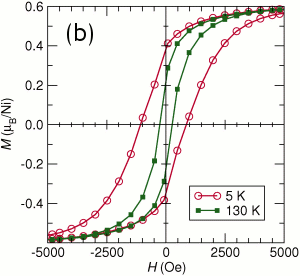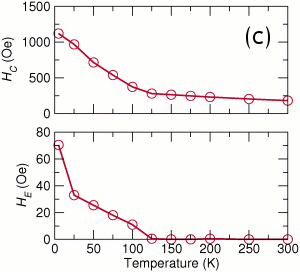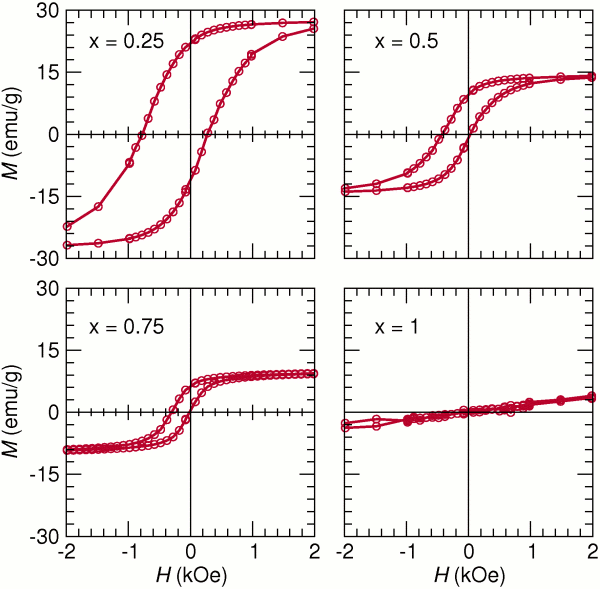

45283-AC10
Porous and Biphasic Materials through Solid State Reactions
We are continuing our investigation of rapid, spontaneous routes to the self-assembly of mesoporous and biphasic materials. By utilizing novel chemical techniques and considering complex phase equilibria, we are establishing a toolkit for the production of composites with potential applications ranging from filtration and catalysis to magnetoelectric coupling and magnetic exchange bias. Here, we outline two of our approaches.
- Vapor-phase leaching
Last year, we described a hydrogen reduction process which converts dense, ceramic monoliths into hierarchically porous single-phase oxides. Extension of this procedure to ternary oxides such as NiMn2O4 yields two reduction processes below 700°C:
The metal nanoparticles and their intimate contact with the oxide monolith produce a highly interfacial composite. Because MnO is an antiferromagnet below its Néel temperature (TN = 119 K) and Ni is a ferromagnet, we can probe the interface by characterizing the magnetic exchange bias between them.
Cooling below TN in an applied 5 T magnetic field leads to irreversibility when the field direction is switched, and the observable result is a shift of the magnetic hysteresis loop along the field axis. A shifted loop can be seen in Fig. 1(b). The magnitude of the shift is the exchange bias field HE. Fig. 1(c) shows the confirmation of exchange bias in our Ni/MnO composite: HE appears at TN and increases upon cooling. We can tailor HE and HC by choosing the starting composition of NixMn3-xO4 with 0 < x ≤ 1.
Traditional routes to exchange biased nanocomposites have been uncontrolled partial reduction of oxide nanoparticles, high-energy ball milling, or high-cost thin film techniques with complex geometries and small volumes. Our process allows for rapid self-assembly of bulk exchange biased composites in pellet, film, or powder forms.
- Magnetically probing heterogeneous oxide solid solutions
Our investigations of highly interfacial oxide composites has led us to magnetically complex solid solutions containing Jahn-Teller distorting ions (mostly d4 Mn3+ or d9 Cu2+) in stretched MO6 octahedra or MO4 tetrahedra. Our focus lies on two spinel systems: (CuxMg1-x)Cr2O4 and (ZnxMn1-x)Mn2O4, both with 0 ≤ x ≤ 1.
There is a strong preference for Cr to occupy the octahedral positions in the first spinel, so the solid solution ranges between zero and full occupation of the tetragonal sites by either Cu or Mg. The tetrahedral Cu2+ ions are Jahn-Teller active while the Mg2+ are not. CuCr2O4 is a tetragonal ferromagnet and MgCr2O4 is a cubic antiferromagnet. By changing the composition x, we can adjust the cubic-tetragonal transition from liquid helium temperatures to over 700°C.
Two opportunities are presented by this system: what is the magnetic response when two competing magnetic phases exist at low temperatures, and can we impart heterogeneity by quenching a two-phase sample to low temperatures?
Our preliminary neutron scatting studies observe the transition around 50 K in the composition (Cu0.2Mg0.8)Cr2O4. We hope to observe competing ferromagnetic Cu-rich regions and antiferromagnetic Mg-rich regions, which can produce exchange bias or glassy magnetism.
We are encouraged by our recent measurements of (ZnxMn1-x)Mn2O4, showing a strongly shifted exchange-biased magnetic hysteresis loop seen in Fig. 2. In this system, Mn occupies the octahedral sites and the tetrahedral sites vary from zero to full Zn or Mn occupation. Since the Jahn-Teller tendency on the tetrahedral site is suppressed, the driving force may be weaker for Zn clustering than for Cu clustering in the (CuxMg1-x)Cr2O4 system.
- Personal Impact
Since receiving support from the PRF, Ram Seshadri has received tenure in the UCSB Materials Department. Eric S. Toberer has earned his PhD in Materials. He is currently in a postdoctoral position at Caltech and was awarded a Beckman Fellowship. Graduate student Daniel P. Shoemaker has been researching functional biphasic materials since Fall 2006 and will advance to candidacy in Fall 2008.
Figures



Fig. 1. (a) A Ni/MnO composite prepared by selective vapor-phase leaching shows Ni nanoparticles supported by mesoporous MnO. The magnetic hysteresis loop (b) is shifted and broadened along the field axis after field cooling below the Néel temperature (TN) to 5 K. In (c), temperature dependence of the loop shift HE and coercivity HC indicates exchange bias below TN = 119 K.

Fig. 2. Hysteresis loops of (ZnxMn1-x)Mn2O4 at 5 K show significant shifting along the field axis, indicative of exchange bias or glassy magnetism.